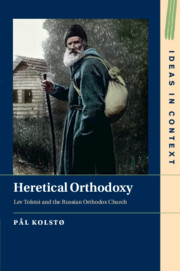Book contents
- Heretical Orthodoxy
- Ideas in Context
- Heretical Orthodoxy
- Copyright page
- Contents
- Preface
- Chapter 1 Introduction
- Chapter 2 Tolstoi as a Practicing Orthodox
- Chapter 3 Tolstoi’s Examination of Dogmatic Theology
- Chapter 4 Tolstoi, Orthodoxy and Asceticism
- Chapter 5 Lev Tolstoi and Orthodox Forms of Spirituality: Elders
- Chapter 6 Tolstoi and the Wanderer Tradition in Russian Culture
- Chapter 7 Tolstoi and the Ideal of “the Holy Fool”
- Chapter 8 Father Sergius: Kasatskii’s Spiritual Journey to Holy Foolishness
- Chapter 9 Tolstoi and the Social Ideal of the Eastern Church: John Chrysostom
- Chapter 10 The Church Mounts a Counterattack: Threat Perceptions and Combat Strategies
- Chapter 11 Between “Almost Orthodox” and “Antichrist”: Images of Lev Tolstoi in Russian Orthodox Polemics
- Chapter 12 The “Excommunication” and Its Aftermath
- Chapter 13 A Requiem for a Heretic? The Controversy over Lev Tolstoi’s Burial
- Chapter 14 Summary and Conclusions
- Bibliography
- Index
Chapter 10 - The Church Mounts a Counterattack: Threat Perceptions and Combat Strategies
Published online by Cambridge University Press: 15 September 2022
- Heretical Orthodoxy
- Ideas in Context
- Heretical Orthodoxy
- Copyright page
- Contents
- Preface
- Chapter 1 Introduction
- Chapter 2 Tolstoi as a Practicing Orthodox
- Chapter 3 Tolstoi’s Examination of Dogmatic Theology
- Chapter 4 Tolstoi, Orthodoxy and Asceticism
- Chapter 5 Lev Tolstoi and Orthodox Forms of Spirituality: Elders
- Chapter 6 Tolstoi and the Wanderer Tradition in Russian Culture
- Chapter 7 Tolstoi and the Ideal of “the Holy Fool”
- Chapter 8 Father Sergius: Kasatskii’s Spiritual Journey to Holy Foolishness
- Chapter 9 Tolstoi and the Social Ideal of the Eastern Church: John Chrysostom
- Chapter 10 The Church Mounts a Counterattack: Threat Perceptions and Combat Strategies
- Chapter 11 Between “Almost Orthodox” and “Antichrist”: Images of Lev Tolstoi in Russian Orthodox Polemics
- Chapter 12 The “Excommunication” and Its Aftermath
- Chapter 13 A Requiem for a Heretic? The Controversy over Lev Tolstoi’s Burial
- Chapter 14 Summary and Conclusions
- Bibliography
- Index
Summary
Chapter 10 shows how the “Tolstoi phenomenon” was perceived by members of the Russian Church, why they saw him as a major threat, and how Orthodox believers discussed various strategies for combating this new heresy. Earlier, the Russian church had been confronted by various sectarian movements among the common people, on the one hand, and increasing atheism among the intelligentsia and the upper classes, on the other hand. When Tolstoi stood forth as a religious teaching, he combined elements of both these currents, and was therefore perceived as a far more formidable threat than either of them. It was therefore incumbent upon the Orthodox to stem the spread of his ideas. Among the tools available in this struggle was censorship – a well-established institution in Russian society, but one that was a double-edged sword that could also have severely deleterious consequences. It was no small matter to censor the country’s indisputably most famous writer: Therefore, only the most offensive of Tolstoi’s religious writings were totally forbidden, while many others passed through the screening with only certain sections and expressions deleted. In consequence, to the reading public in Russia, Tolstoi’s anti-Orthodox message was made to appear far more innocuous than it actually was.
- Type
- Chapter
- Information
- Heretical OrthodoxyLev Tolstoi and the Russian Orthodox Church, pp. 156 - 180Publisher: Cambridge University PressPrint publication year: 2022



